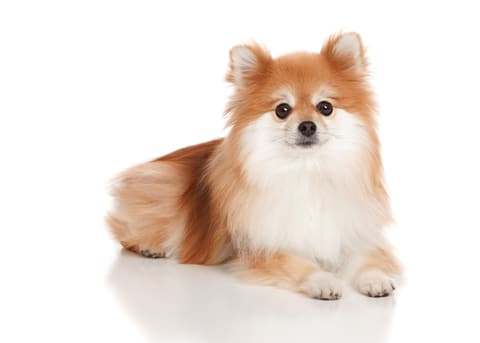

Are Pomeranians Friendly With cats?
Are you considering having Pomeranians and cats as pets? Then you must be asking yourself, 'are Pomeranians friendly with cats?'. Read on to find the answer to your question, along with a wealth of other relevant information.
Are Pomeranians friendly with cats? Owners of Pomeranians or cats – or those planning to adopt them, this is a valid thing to wonder. Cats and Pomeranians are similar in size, and despite their differences, will usually get along well with each other. However, if you wish to have a feline and canine pet living together, there are several guidelines to adhere to, which we will be discussing in this blog. Moreover, you will also learn several tips and tricks that will help you establish a healthy bond between the two pets.
1. If you own Pomeranians and Cats, here is what you need to do
1.1 What to do about Pomeranians?
If you have a dog that is constantly barking or lashing out at cats, or displays a general intolerance towards them, you might want to reconsider your decision of getting a pet cat. However, if your dog is curious about cats or simply does not care, this is usually a positive indication.
The next factor is your confidence in your ability to get your dog to obey your commands. If your dog gets tensed in certain situations – situations that require you to intervene and get him to do what you need – then you should always have commands like sit, down, stay, heel, and come in your armory.
It is crucial to dedicate a lot of time and effort to train your dog to respond to what you say, but almost all owners get to that point sooner or later. Finally, if you have a pet cat neighbor, you need to ask them if you can bring your dog over when visiting. This visit will help you assess the results of your training, allowing you to see the extent to which your dog will adhere to your commands despite being in a room containing a cat.
1.2 What to do about cats?
If you have a Pomeranian and want to get a cat, it is best to bring in a kitten or a young cat. This way, your cat will be around your other pets from a very young age, which will increase the chances of the Pomeranian and the cat becoming excellent friends.
If you consider adopting an adult cat from a shelter, you should find out as much information as possible about the animal. For instance, you should know if the cat has spent any time in homes that contained dogs. Before coming to a decision or making a commitment, make the cat smell a piece of cloth or blanket that belongs to your dog. Scents tend to stick to such items and, if you see the cat expressing a dislike for that scent, you can use that to make your decision.
Certain cats will even hiss when they smell something with a dog’s scent – the hiss is a massive red flag because it indicates animosity. Instead, what you should be looking for is indifference.
2. How to Introduce a Cat and a Pomeranian?
If you have done the things discussed in this blog so far, you should expect the first meeting to go well. However, it is impossible to predict the outcome of the meeting, so you should adhere to certain precautions.
Neither animal should be without its owner – this will ensure supervision, and the owners can take any required direct action. Depending on the initial interaction, the owners might need to be present for the first few times. Once you are sure that there will be no more problems, you can leave the two animals unsupervised.
A gradual introduction is best. So, before the cat and Pomeranian have their first face-to-face interaction, here are a few things that you can do to make either animal aware of the other’s presence:
- The homeowner needs to select a specific room where the dog will stay until it is time for the introduction. Even though you are confining the dog, he should not think that it is a punishment. Ideally, a family member should stay with the dog to keep him occupied or even give him an occasional treat or some new toys to occupy and distract himself with.
- As soon as that is done, it’s time to bring the cat inside and show him around the house. Be sure to make him visit your dog’s sleeping and playing area (as these are the areas where the dog’s scent will be the most intense). Once the tour is complete, let your dog out and allow him to take in the scents that the cat has just left behind.
- After this step, bring the cat and the Pomeranian close together for a brief meeting (do not forget to keep the dog on a leash). Give the cat the opportunity to go back if required. Remember that cats hate getting cornered and if he gets scared of the dog, he will need to climb or jump to a secure spot.
Of course, the ideal outcome is that the two animals get along perfectly well from the first day. However, this is often too good to be true. So, if they express interest, that is good, but even if they are indifferent, that is more than a decent result.
If either animal can pretend that the other is simply nonexistent, take it as a positive sign because it shows that neither of the two animals feels scared or threatened in the other’s presence. Unfortunately, once the two animals realize that they will have to live with each other in the same house and not just for a short while, this indifferent attitude might cease to exist. So, it is crucial to keep a close eye on both animals until they are able to accept the situation and each other.
3. How to Befriend Canines and Felines?
It will take approximately three weeks to determine how your Pomeranian and cat are getting along with each other. If you want to speed up the process of friendship between the two, here are a few things that you can do:
- Avoid forcing the pets to become friends. They will do things their way and require you to give them the independence that they need. Forcing them to remain in the same room to catalyze friendship is just going to make them come at each other’s throats.
- Dedicate a separate place for either pet. Even if they do become friends and start to enjoy spending time together, there will be times when they will need their own space and solitude.
- Cats and dogs have very different food requirements and preferences. For instance, cat foods contain a higher percentage of protein and more salts in comparison to dog meals. So, make sure that your dog does not eat your cat’s food, and vice versa. Doing this every once in a while might not hurt much, but if it happens on a regular basis, your pets might end up with health problems like diarrhea or upset stomachs. Also, cats love catnip because of the stimulating effects. However, if your dog ends up eating catnip, it will lead to sedation, water loss, stomach aches, and diarrhea.
- Keep a different eating time for the pets. If you make them eat together, both of them might fear the other pet coming for their food, and you do not want to instigate this stressful event.
- As far as sleeping arrangements go, make sure that your cat has a separate bed out of reach of the dog – at least until you have ascertained that the two can get along together.
- Observe your cat and dog’s relationship for a week; if there are positive signs, give one shot at feeding them together. Eating together will help them create a connection and understand that both are members of a single home or pack.
- If your dog is behaving well around your cat, praise or treat him. This will help your dog learn that this behavior is appreciated and should therefore be replicated.
4. The Last Word: Are Pomeranians Friendly With Cats?
The answer to the question ‘are Pomeranians friendly with cats?’ is a resounding YES. In most cases, cats and Pomeranians are quick to bond and become friends.
Discover how to create a joyful, healthy home for your pet.
Subscribe to your weekly rundown of practice, real life ideas and training tips straight to your inbox.


